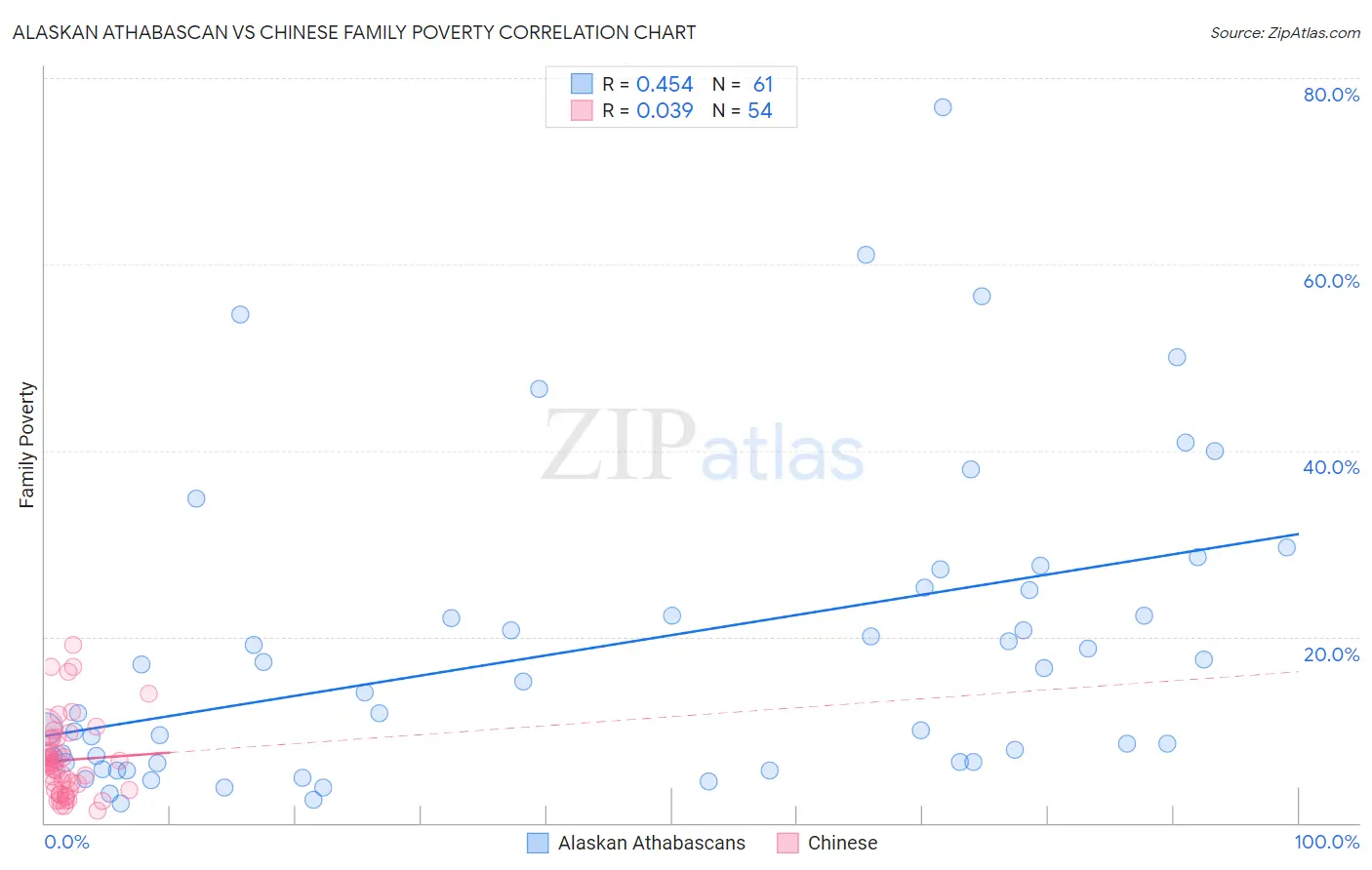Alaskan Athabascan vs Chinese Family Poverty
COMPARE
Alaskan Athabascan
Chinese
Family Poverty
Family Poverty Comparison
Alaskan Athabascans
Chinese
10.1%
FAMILY POVERTY
2.7/ 100
METRIC RATING
231st/ 347
METRIC RANK
6.5%
FAMILY POVERTY
100.0/ 100
METRIC RATING
2nd/ 347
METRIC RANK
Alaskan Athabascan vs Chinese Family Poverty Correlation Chart
The statistical analysis conducted on geographies consisting of 45,790,128 people shows a moderate positive correlation between the proportion of Alaskan Athabascans and poverty level among families in the United States with a correlation coefficient (R) of 0.454 and weighted average of 10.1%. Similarly, the statistical analysis conducted on geographies consisting of 64,784,795 people shows no correlation between the proportion of Chinese and poverty level among families in the United States with a correlation coefficient (R) of 0.039 and weighted average of 6.5%, a difference of 54.7%.

Family Poverty Correlation Summary
| Measurement | Alaskan Athabascan | Chinese |
| Minimum | 2.0% | 1.3% |
| Maximum | 76.9% | 19.1% |
| Range | 74.9% | 17.8% |
| Mean | 18.8% | 6.8% |
| Median | 14.0% | 6.3% |
| Interquartile 25% (IQ1) | 6.5% | 3.5% |
| Interquartile 75% (IQ3) | 25.1% | 9.0% |
| Interquartile Range (IQR) | 18.6% | 5.5% |
| Standard Deviation (Sample) | 16.5% | 4.1% |
| Standard Deviation (Population) | 16.3% | 4.1% |
Similar Demographics by Family Poverty
Demographics Similar to Alaskan Athabascans by Family Poverty
In terms of family poverty, the demographic groups most similar to Alaskan Athabascans are Immigrants from Panama (10.0%, a difference of 0.38%), Immigrants from Uzbekistan (10.0%, a difference of 0.40%), Sudanese (10.0%, a difference of 0.41%), Immigrants from Sudan (10.1%, a difference of 0.43%), and Immigrants from Armenia (10.0%, a difference of 0.62%).
| Demographics | Rating | Rank | Family Poverty |
| Marshallese | 3.9 /100 | #224 | Tragic 9.9% |
| Immigrants | Immigrants | 3.6 /100 | #225 | Tragic 10.0% |
| Ottawa | 3.3 /100 | #226 | Tragic 10.0% |
| Immigrants | Armenia | 3.3 /100 | #227 | Tragic 10.0% |
| Sudanese | 3.1 /100 | #228 | Tragic 10.0% |
| Immigrants | Uzbekistan | 3.1 /100 | #229 | Tragic 10.0% |
| Immigrants | Panama | 3.1 /100 | #230 | Tragic 10.0% |
| Alaskan Athabascans | 2.7 /100 | #231 | Tragic 10.1% |
| Immigrants | Sudan | 2.3 /100 | #232 | Tragic 10.1% |
| Fijians | 2.1 /100 | #233 | Tragic 10.1% |
| Immigrants | Middle Africa | 2.1 /100 | #234 | Tragic 10.1% |
| Nigerians | 2.0 /100 | #235 | Tragic 10.1% |
| Immigrants | Nigeria | 1.9 /100 | #236 | Tragic 10.2% |
| Immigrants | Laos | 1.7 /100 | #237 | Tragic 10.2% |
| French American Indians | 1.5 /100 | #238 | Tragic 10.2% |
Demographics Similar to Chinese by Family Poverty
In terms of family poverty, the demographic groups most similar to Chinese are Immigrants from Taiwan (6.6%, a difference of 1.6%), Filipino (6.6%, a difference of 2.2%), Thai (6.7%, a difference of 2.8%), Immigrants from India (6.2%, a difference of 4.3%), and Norwegian (6.9%, a difference of 5.9%).
| Demographics | Rating | Rank | Family Poverty |
| Immigrants | India | 100.0 /100 | #1 | Exceptional 6.2% |
| Chinese | 100.0 /100 | #2 | Exceptional 6.5% |
| Immigrants | Taiwan | 100.0 /100 | #3 | Exceptional 6.6% |
| Filipinos | 100.0 /100 | #4 | Exceptional 6.6% |
| Thais | 100.0 /100 | #5 | Exceptional 6.7% |
| Norwegians | 99.9 /100 | #6 | Exceptional 6.9% |
| Immigrants | Ireland | 99.9 /100 | #7 | Exceptional 7.0% |
| Bhutanese | 99.9 /100 | #8 | Exceptional 7.0% |
| Latvians | 99.9 /100 | #9 | Exceptional 7.1% |
| Bulgarians | 99.8 /100 | #10 | Exceptional 7.1% |
| Immigrants | Singapore | 99.8 /100 | #11 | Exceptional 7.1% |
| Maltese | 99.8 /100 | #12 | Exceptional 7.1% |
| Swedes | 99.8 /100 | #13 | Exceptional 7.1% |
| Iranians | 99.8 /100 | #14 | Exceptional 7.1% |
| Lithuanians | 99.8 /100 | #15 | Exceptional 7.2% |